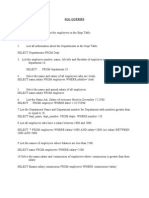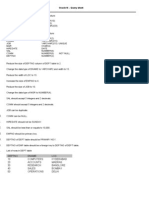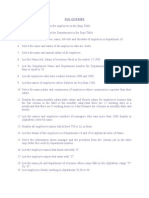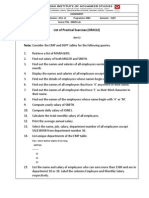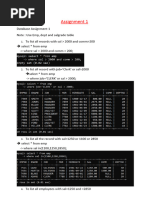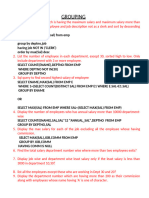Introduction Oracle SQL and Pl SQL
Uploaded by
Mayank KumarIntroduction Oracle SQL and Pl SQL
Uploaded by
Mayank KumarIntroduction Oracle SQL and PL/SQL
Login to SCOTT schema and write queries for the following:
Module 1/Day 1
SELECT Statement:
1. List tables in your schema and check for existence of DEPT, EMP and SALGERADE tables
2. If these tables do NOT exists – execute the script in the embedded DemoBld.SQL file to create
and populate the tables .
3. List all columns and all rows from DEPT
4. List all columns and all rows from EMP
5. List all columns and all rows from SALGRADE
6. List employee number, name and salary from employee table
7. List employee number, name and salary from employee table where salary is > 3000
8. List employees joined after year 1981
9. List all clerks (JOB = ‘CLERK’)
10. List employees in the ascending order of salary
11. List employees in ascending order of job within descending order of deptno
12. List distinct departments from employee table
13. List distinct jobs in each department from employee table
14. List name, salary and annual salary in the descending order of annual salary – annual salary is a
computed column – SAL * 12
15. List employees whose salary is not in the range of 2000 and 3000
16. List name and the deptno for all employees who are NOT members of departments 10 and 20
17. List employees for whom COMM is not applicable
18. List employees for whom COMM is applicable
19. List employees in ascending order of COMM and note how NULLs are sorted
20. List employees whose names start with ‘’SMITH’
Sensitivity: Internal & Restricted
21. List employees whose name contain the ‘MI’
22. List employees whose name start with an _ (underscore) char.
23. List all employees joined between two given dates.
24. List all clerks in deptno 10
25. List total/sum, maximum, minimum, average of salary from employee table
26. List average and count of commission of all employees in department 10
27. List department wise no of employees and total salary
28. List total salary Job wise within each department
29. List department wise total salary for deptno 10 and 20 only
30. List department wise total salary where total salary is > 6000
31. SELECT COUNT(*), COUNT(COMM) FROM EMP; - explain why the two counts are different
Sub Queries:
1. List employees whose job is same as that of ‘SMITH’
2. List employees who have joined after ‘ADAM’
3. List employees who salary is greater than ‘SCOTT’s salary
4. List employees getting the maximum salary
5. List employees show salary is > the max salary of all employees in deptno 30
6. List all employees whose deptno and Job are same as that of employee with empno 7788.
7. List employee who are not managers
8. List all managers
9. List all employees who earn(salary) more than the average salary in their own department
10. List employees whose salary is greater than their manager’s salary
11. List details of departments from DEPT table for which there are no employees in EMP table
Sensitivity: Internal & Restricted
Module 2/Day 2
Joins:
1. List employee name, department number and their corresponding department name by joining
EMP and DEPT tables
2. List employee name and their manager name by joining EMP table to itself
3. List employee name, department name and their grade by joining EMP, DEPT and SALGRADE
tables
4. List employees who work in ‘Research’ department by joining EMP and DEPT tables
5. List all rows from EMP table and only the matching rows from DEPT table – LEFT OUTER JOIN
6. List only matching rows from EMP table and all rows from DEPT table – RIGTH OUTER JOIN
7. Write a query to perform full outer join between EMP and DEPT tables
8. List employee name, their manager name and their manager’s manager name
DDL
1. Create DEPARTMENT table with the following columns with appropriate data type and width
a) Deptno PK
b) Danme
c) Location
2. Create EMPLOYEE table with the following columns with appropriate data type and width
a. empno PK
b. ename not null
c. designation
d. sex
e. basic_salary (> 0 and < 500000)
f. Date of joining
g. Deptno reference deptno of DEPARTMENT table
3. Alter table EMPLOYEE add column commission
4. Alter table EMPLOYEE add constraint SEX in (‘M’, ‘F’)
4. Create Index on ename column of EMPLOYEE table
5. Create exact replica of EMPLOYEE table with no data
Sensitivity: Internal & Restricted
6. Create new table called EX_EMP with columns empno, ename, basic_salary and populate the data
from EMPLOYEE table
7. Drop the Index created on ename column.
DML
1. Insert at least 5 valid rows into DEPARTMENT table and commit the changes
2. Insert at least 15 valid rows in EMPLOYEE table and commit the changes
3. Update basic_salary by 10% for employees in deptno 10 and 20 and commit the changes
4. Update basic_salary and commission by 10% and 2% for all employees for whom commission is
currently applicable and commit the changes
5. Update the designation of given employee to MANAGER based of given employee number and
commit the changes.
6. Delete employees joined before a given year and commit changes
7. Delete all rows from employee tables.
8. Query employee table
9. ROLLBACK
10. Query employee table
11. Delete all rows from employee tables permanently using appropriate DDL command
Procedure and Functions:
1. Create a procedure named DISP_EMP_DETAILS with 3 parameters one [ie. iEmpNo ] is an “IN”
mode and other two are [ie. sGrade and sSalary] “OUT” mode parameters. The procedure should
retrieve the Grade (this is column of SALGRADE table) and Salary for the specified employee number
[ie. iEmpNo ] by joining EMP and SALGRADE table and assign the retrieved values to the “OUT”
mode parameters.
Note.:
It should display an appropriate error message if the specified employee number
does not exist in “Employee” table.
Call the created procedure using Bind variable and print the details.
2. Create a procedure named DISPLAY_RECORDS which accepts the P_JOB as a parameter and display
all the employees (empno, sal, deptno, job) from the “EMP” table matching the given P_JOB in the
following format :-
EmployeeNumber Salary DepartmentNumber Job
XXXXXXXX 99,999 99 CLERK
XXXXXXXX 9,999 12 CLERK
Note.:
It should display an appropriate error message if there are no employees with the given JOB
3. Create a function named GET_EMP_ANNSAL which accepts employee Number as
Sensitivity: Internal & Restricted
a parameter and Returns Annual Salary of the given employee from EMP table if the record exist
otherwise returns -1 ( formula to computer ANNUAL_SALARY = SAL * 12)
Sensitivity: Internal & Restricted
You might also like
- KX-NS Version 8.0 Software Release Note: October 15, 2019No ratings yetKX-NS Version 8.0 Software Release Note: October 15, 201942 pages
- Oracle Assignment 2019: Grade NUMBER, Losal NUMBER, Hisal NUMBERNo ratings yetOracle Assignment 2019: Grade NUMBER, Losal NUMBER, Hisal NUMBER8 pages
- S.No. Topic Date Sign. Remark 1. 2. 3. 4. 5. 6. Display The Employees Name With Their Annual Salary. 7. 8. 9. 10No ratings yetS.No. Topic Date Sign. Remark 1. 2. 3. 4. 5. 6. Display The Employees Name With Their Annual Salary. 7. 8. 9. 1038 pages
- Create The Following Tables With The Given Structures and DataNo ratings yetCreate The Following Tables With The Given Structures and Data10 pages
- List All Information About All Employees From Emp Table: SQL Select From Emp Where Deptno Not in (10,30,40)No ratings yetList All Information About All Employees From Emp Table: SQL Select From Emp Where Deptno Not in (10,30,40)7 pages
- Key and Forigen Key: 1. Create A Table and Specific The PrimaryNo ratings yetKey and Forigen Key: 1. Create A Table and Specific The Primary5 pages
- DB2 11.1 for LUW: SQL Basic Training for Application DevelopersFrom EverandDB2 11.1 for LUW: SQL Basic Training for Application DevelopersNo ratings yet
- Pivot Tables for everyone. From simple tables to Power-Pivot: Useful guide for creating Pivot Tables in ExcelFrom EverandPivot Tables for everyone. From simple tables to Power-Pivot: Useful guide for creating Pivot Tables in ExcelNo ratings yet
- The Routledge Companion To Design Research by Rodgers, Paul A.yee, JoyceNo ratings yetThe Routledge Companion To Design Research by Rodgers, Paul A.yee, Joyce539 pages
- Electric Power Systems Research: SciencedirectNo ratings yetElectric Power Systems Research: Sciencedirect7 pages
- Real-Time Inventory Management With RFIDashNo ratings yetReal-Time Inventory Management With RFIDash10 pages
- Symantec DLP 15.5 System Requirements GuideNo ratings yetSymantec DLP 15.5 System Requirements Guide75 pages
- Cable Sizing & Voltage Drop Calculations Formula - Electrical Engineering 123No ratings yetCable Sizing & Voltage Drop Calculations Formula - Electrical Engineering 1234 pages
- Detection of Cyber Attack in Network using Machine Learning Techniques (1)No ratings yetDetection of Cyber Attack in Network using Machine Learning Techniques (1)68 pages
- Applied Tele Audiology Research in Clinical Practice During The Past Decade A Scoping ReviewNo ratings yetApplied Tele Audiology Research in Clinical Practice During The Past Decade A Scoping Review10 pages
- Diff.equations and Numerical Methods II Sem.No ratings yetDiff.equations and Numerical Methods II Sem.1 page
- Elementary Matrices and RREF: N N I Ij IjNo ratings yetElementary Matrices and RREF: N N I Ij Ij3 pages
- Project Report 2004 Solar: A Solar System Simulator Author: Sam Morris Supervisor: Dr. Richard BanachNo ratings yetProject Report 2004 Solar: A Solar System Simulator Author: Sam Morris Supervisor: Dr. Richard Banach56 pages
- KX-NS Version 8.0 Software Release Note: October 15, 2019KX-NS Version 8.0 Software Release Note: October 15, 2019
- Oracle Assignment 2019: Grade NUMBER, Losal NUMBER, Hisal NUMBEROracle Assignment 2019: Grade NUMBER, Losal NUMBER, Hisal NUMBER
- S.No. Topic Date Sign. Remark 1. 2. 3. 4. 5. 6. Display The Employees Name With Their Annual Salary. 7. 8. 9. 10S.No. Topic Date Sign. Remark 1. 2. 3. 4. 5. 6. Display The Employees Name With Their Annual Salary. 7. 8. 9. 10
- Create The Following Tables With The Given Structures and DataCreate The Following Tables With The Given Structures and Data
- List All Information About All Employees From Emp Table: SQL Select From Emp Where Deptno Not in (10,30,40)List All Information About All Employees From Emp Table: SQL Select From Emp Where Deptno Not in (10,30,40)
- Key and Forigen Key: 1. Create A Table and Specific The PrimaryKey and Forigen Key: 1. Create A Table and Specific The Primary
- DB2 11 for z/OS: SQL Basic Training for Application DevelopersFrom EverandDB2 11 for z/OS: SQL Basic Training for Application Developers
- SQL Server Functions and tutorials 50 examplesFrom EverandSQL Server Functions and tutorials 50 examples
- DB2 11.1 for LUW: SQL Basic Training for Application DevelopersFrom EverandDB2 11.1 for LUW: SQL Basic Training for Application Developers
- Pivot Tables for everyone. From simple tables to Power-Pivot: Useful guide for creating Pivot Tables in ExcelFrom EverandPivot Tables for everyone. From simple tables to Power-Pivot: Useful guide for creating Pivot Tables in Excel
- The Routledge Companion To Design Research by Rodgers, Paul A.yee, JoyceThe Routledge Companion To Design Research by Rodgers, Paul A.yee, Joyce
- Cable Sizing & Voltage Drop Calculations Formula - Electrical Engineering 123Cable Sizing & Voltage Drop Calculations Formula - Electrical Engineering 123
- Detection of Cyber Attack in Network using Machine Learning Techniques (1)Detection of Cyber Attack in Network using Machine Learning Techniques (1)
- Applied Tele Audiology Research in Clinical Practice During The Past Decade A Scoping ReviewApplied Tele Audiology Research in Clinical Practice During The Past Decade A Scoping Review
- Project Report 2004 Solar: A Solar System Simulator Author: Sam Morris Supervisor: Dr. Richard BanachProject Report 2004 Solar: A Solar System Simulator Author: Sam Morris Supervisor: Dr. Richard Banach








